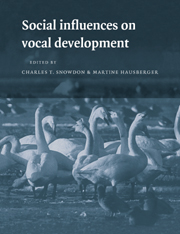Book contents
- Frontmatter
- Contents
- List of contributor
- 1 Introduction
- 2 Social interaction and sensitive phases for song learning: A critical review
- 3 Social interaction and vocal development in birds
- 4 Building a social agenda for the study of bird song
- 5 Field observations, experimental design, and the time and place of learning bird songs
- 6 Vocal learning in wild and domesticated zebra finches: Signature cues for kin recognition or epiphenomena?
- 7 What birds with complex social relationships can tell us about vocal learning: Vocal sharing in avian groups
- 8 Social influences on song acquisition and sharing in the European starling (Sturnus vulgaris)
- 9 Social influences on the acquisition of human-based codes in parrots and nonhuman primates
- 10 Vocal learning in captive bottlenose dolphins: A comparison with humans and nonhuman animals
- 11 Vocal learning in cetaceans
- 12 Social influences on vocal development in New World primates
- 13 Some general features of vocal development in nonhuman primates
- 14 Social influences on vocal learning in human and nonhuman primates
- 15 The resilience of language in humans
- 16 Reciprocal interactions and the development of communication and language between parents and children
- 17 Crafting activities: Building social organization through language in girls' and boys' groups
- Index
14 - Social influences on vocal learning in human and nonhuman primates
Published online by Cambridge University Press: 04 August 2010
- Frontmatter
- Contents
- List of contributor
- 1 Introduction
- 2 Social interaction and sensitive phases for song learning: A critical review
- 3 Social interaction and vocal development in birds
- 4 Building a social agenda for the study of bird song
- 5 Field observations, experimental design, and the time and place of learning bird songs
- 6 Vocal learning in wild and domesticated zebra finches: Signature cues for kin recognition or epiphenomena?
- 7 What birds with complex social relationships can tell us about vocal learning: Vocal sharing in avian groups
- 8 Social influences on song acquisition and sharing in the European starling (Sturnus vulgaris)
- 9 Social influences on the acquisition of human-based codes in parrots and nonhuman primates
- 10 Vocal learning in captive bottlenose dolphins: A comparison with humans and nonhuman animals
- 11 Vocal learning in cetaceans
- 12 Social influences on vocal development in New World primates
- 13 Some general features of vocal development in nonhuman primates
- 14 Social influences on vocal learning in human and nonhuman primates
- 15 The resilience of language in humans
- 16 Reciprocal interactions and the development of communication and language between parents and children
- 17 Crafting activities: Building social organization through language in girls' and boys' groups
- Index
Summary
INTRODUCTION
In this chapter, we review work on the nature of vocal learning in human primates, comparing them en passant to nonhuman primates who share many of their capacities but are both less eager and less successful vocal learners. The basic question underlying this review is whether the precocious and prolific vocal learning of human primates can be explained by biological mechanisms that are specific to the language system or whether it relates to more general social capacities and to the particular social context of vocal learning in humans.
We know that young human primates are particularly good at vocal learning. One bit of evidence in support of this contention is that all national languages are spoken, even though extremely subtle articulatory and auditory discriminations are relied on to carry meaning in spoken languages. In addition, babbling and vocal play are early developmental activities universally observed in normally developing children (Locke 1992; Locke & Pearson 1992). Imitative vocal behavior is also universal in young children and common even in more mature language users. Furthermore, language learning, particularly word learning, by young children, is quite rapid and efficient.
Although there is much emphasis on children's preparedness for language learning, in fact children everywhere seem to enter the language system of conventional words use through the use of vocal forms that are more like adult forms in sound than in semantic or syntactic function. These early forms could be argued, though, to foreshadow a major function of oral language even in adulthood, namely to effect participation in social interaction rather than transmission of information.
- Type
- Chapter
- Information
- Social Influences on Vocal Development , pp. 274 - 292Publisher: Cambridge University PressPrint publication year: 1997
- 17
- Cited by

